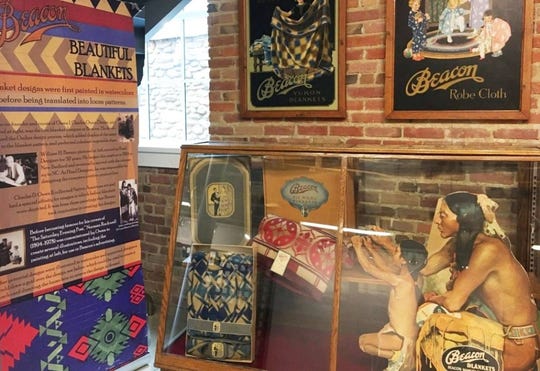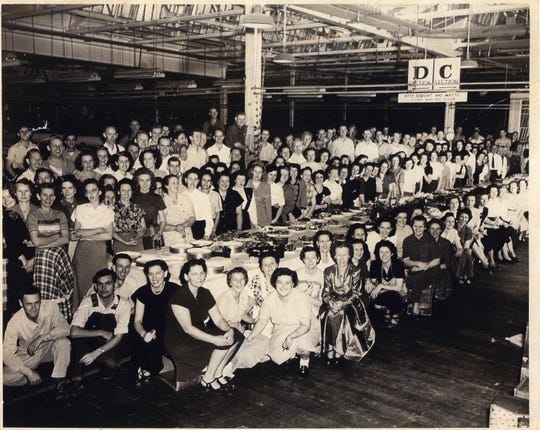Special to Black Mountain News,Published 1:11 p.m. ET April 24, 2019
In honor of May Day, known around the world as International Workers’ Day, the Swannanoa Valley Museum will officially celebrate the opening of its Beacon Blankets exhibit with an evening reception.
The Beacon Manufacturing Company operated in Swannanoa from 1924-2002 and was once the largest blanket manufacturer in the world. Today, many of their beautiful blankets are collector’s items. The exhibit highlights several aspects of Beacon’s history, including its controversial use of the term “Indian Design” when advertising its blankets, workers’ striking and union efforts, and the lives and culture of Beacon’s Swannanoa community. Members of the public are invited to come by, view the exhibit, and gain an appreciation for the lives and culture of Beacon workers in the early 20th century. Beverages and snacks will be served.

Beacon Blankets exhibit at Swannanoa Valley Museum
About the Beacon Manufacturing Company
Originally located in New Bedford, Massachusetts, Beacon Blankets moved its entire operations to Swannanoa in the midst of the Depression under the guidance of the company’s owner Charles D. Owen II.
Owen’s decision was representative of an era in which many northern companies moved their manufacturing south to gain greater access to cheap labor and resources such as water, cotton, and timber. The move was likely also motivated by increased union activity in New Bedford, which Owen, like many northern factory owners, hoped to avoid in southern communities.
In 1936, after the massive effort of moving machinery and infrastructure from north to south, Beacon Manufacturing completed its new 1 million-square-foot plant in Swannanoa, heralding an era of prosperity for the company. Beacon became the world’s largest mill, and at its peak, the giant factory employed 2,200 people. The company came to be famous for its use of vibrant colors and the Ombre design process, which added shades of the same color to blanket patterns.
Beacon transformed Swannanoa into a mill town with company-owned houses and company-sponsored entertainment and sports teams. While amenities such as mill village housing were provided as a strategy to discourage workers from organizing, the bustling, close-knit community that formed around the mill is fondly remembered by former residents. In a 2012 interview, Joan Barnwell recalled the ways in which Swannanoa thrived during Beacon’s heyday, saying, “We had a department store, we had a furniture store. … We had a theater and … two drugstores.”

Beacon Mills Employee 1939 first Christmas dinner in Spinning Filling Warp Room (Photo: Courtesy of Swannanoa Valley Museum)
Multiple generations of Swannanoa Valley residents worked at the mill until its closure in 2002. In 2003, an arsonist set fire to the building, burning it to the ground. Today, the former mill site is an open field situated next to historic mill village housing, now private residences.
While the fate of the site is uncertain, several entities are working to preserve the memory of Beacon’s history in Swannanoa. The Swannanoa Valley Museum maintains collections related to Beacon, and its 2019 exhibit is part of ongoing efforts to educate the public about the history of the mill and its workers. Additionally, Black Mountain resident Rebecca Williams is producing a film, called “Blanket Town,” about the rise and fall of Beacon Manufacturing in Swannanoa. More information about the film is available at www.blankettown.org.
The History of May Day
Since 1891, May Day (falling on May 1) has been commemorated with events including marches for workers’ rights, campaigns for the eight-hour work day, and celebrations of working people everywhere. The holiday was originally created to commemorate the Haymarket affair in Chicago, an incident in which violence broke out between police and striking workers demonstrating for an eight-hour work day. The incident resulted in the deaths of several workers, policemen, and city residents. Hundreds of labor leaders and sympathizers were later rounded up, and four were executed by the state of Illinois.
Although originally founded to honor the memory of the labor organizers executed after the Haymarket Affair, the holiday has expanded to become a celebration of labor across the world. The first of May is a national public holiday in countries across Africa, Europe, and South America. Although the United States officially celebrates the first Monday in September as Labor Day, many labor unions, rights groups, and cities still host large May Day events every year.
If you go
What: Beacon Blanket exhibit opening reception
When: 5-6:30 p.m. May 3
Where: Swannanoa Valley Museum and History Center, 223 West State St., Black Mountain
Cost: Free and open to the public